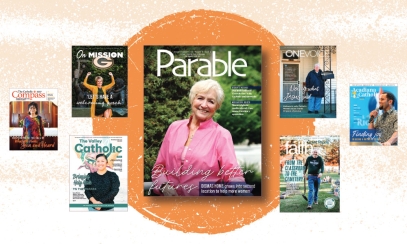
What’s the answer to the funding question for diocesan publications?
Faced with the problem of underwriting the cost of a diocesan publication, Catholic leaders often are in search of a single correct answer to the question, “How should we fund our magazine?” But nearly 25 years of service to bishops and diocesan communications departments affirms there’s no single way to approach the issue of funding. In fact, funding models for diocesan publishing are likely to be as unique as the publications themselves.
So, is the answer …
Faced with the problem of underwriting the cost of a diocesan publication, Catholic leaders often are in search of a single correct answer to the question, “How should we fund our magazine?” But nearly 25 years of service to bishops and diocesan communications departments affirms there’s no single way to approach the issue of funding. In fact, funding models for diocesan publishing are likely to be as unique as the publications themselves.
So, is the answer …
Direct diocesan funding
Because a publication is the principal way in which a bishop communicates with the people in his diocese, a magazine often receives direct funding from the diocese’s operating budget. However, as publications have moved away from the newspaper model and toward an evangelizing mission, some dioceses spread the cost across departments — not only communications — since the publication also promotes diocesan ministries and initiatives. In fact, in some dioceses the magazine is a function of the office of evangelization or even the development office. Understanding its function as more than a news outlet, and as an integrated part of the mission of evangelization, reframes the responsibility to fund it for the benefit of a bishop’s pastoral priorities.
Parish assessment
Where there is full distribution to all registered parish households, it is common for dioceses to ask parishes to pay some of the cost for a membership magazine. There is no other way for a parish or diocese to reach all of its parishioner homes. Moreover, FAITH’s readership research has shown that up to two-thirds of readers spend at least 15 minutes reading each issue of their magazine. With fewer than 20 percent of registered Catholics attending weekly Mass, a publication is a crucial tool to communicate with these Catholics. Considering the actual cost of a typical diocesan magazine, the portion paid by parishes to reach Church members is typically nominal.
For example:
• A recently launched bimonthly diocesan magazine with a circulation of around 85,000 costs only $2.24 annually per household, not including postage.
• Similarly, a recently launched monthly magazine with a circulation of 50,000 costs only about $5.88 annually per household, not including postage.
Sharing this cost with parishes enables parishioners to receive evangelizing and formative content, learn about news and events across the diocese, and connect with the larger Church.
Fundraising
Diocesan publications that focus on evangelization as their primary purpose serve a vital role in the mission of a diocese to share the Gospel. For this reason, many publishers engage in direct fundraising to underwrite the cost. Some dioceses include the publication as a funded ministry in their annual appeals, while others undertake separate fundraising efforts, such as the Diocese of Portland’s annual Harvest Ball which benefits Harvest magazine. Most publications conduct annual reader appeals. The most successful of these are accomplished with a separate direct mail campaign to include a letter from the bishop and a reply envelope. On average, the expected response for a campaign conducted in this way is between $1 and $3 per household.
Advertising and sponsorships
The advertising model that sustained Catholic newspapers for decades still can provide helpful revenue to offset the cost of a diocesan publication, even if it is not the only source of funding. Diocesan newspapers that transition to a magazine format are often able to maintain institutional advertisers and longtime supporters because these publications offer exceptional value and access to reliable readers, especially in markets that no longer have viable daily or weekly newspaper options. Another option for Catholic publishers is to seek out institutional sponsors, such as Catholic healthcare providers, colleges and universities, financial institutions and apostolates. Sponsorships typically include a major ad placement in each issue, and can also offer “advertorial” opportunities that appear similar to regular magazine content. For example, a hospital sponsorship might include regular features about Catholic health professionals fulfilling their vocations of service in the medical profession, or patients who receive lifesaving care.
All of the above
Most diocesan magazines are funded by a combination of revenue streams, including some level of diocesan subsidy, parish assessment, fundraising, sponsorship and advertising. The path least likely to be pursued is the former newspaper subscription model, in which individuals paid annually for the publication to be mailed to their homes. This is because the low number of paid subscribers means the cost of subscriptions is prohibitively high. Instead, funding models that reflect the approach of evangelization-first put the publication into more households, and the cost is typically shared institutionally with parishes rather than individually with comparatively few parishioners.

